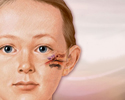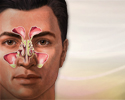Earache
Otalgia; Pain - ear; Ear painAn earache is a sharp, dull, or burning pain in one or both ears. The pain may last a short time or be ongoing. Related conditions include:
- Otitis media
- Swimmer's ear
- Malignant otitis externa
-
Considerations
The symptoms of an ear infection may include:
- Ear pain
- Fever
- Fussiness
- Increased crying
- Irritability
Many children will have minor hearing loss during or right after an ear infection. Most of the time, the problem goes away. Lasting hearing loss is rare, but the risk increases with the number of infections.
-
Causes
The eustachian tube runs from the middle part of each ear to the back of the throat. This tube drains fluid that is made in the middle ear. If the eustachian tube becomes blocked, fluid can build up. This may lead to pressure behind the eardrum or an ear infection.
Ear pain in adults is less likely to be from an ear infection. Pain that you feel in the ear may be coming from another place, such as your teeth, the joint in your jaw (temporomandibular joint), or your throat. This is called referred pain.
Causes of ear pain may include:
- Arthritis of the jaw
- Short-term (acute) ear infection
- Long-term (chronic) ear infection
- Ear injury from pressure changes (from high altitudes and other causes)
- Object stuck in the ear or buildup of ear wax
- Hole in the eardrum
- Sinus infection
- Sore throat
- Temporomandibular joint syndrome (TMJ)
- Tooth infection
Ear pain in a child or infant may be due to infection. Other causes may include:
- Ear canal irritation from cotton-tipped swabs
- Soap or shampoo staying in the ear
-
Home Care
The following steps may help an earache:
- Place a cold pack or cold wet washcloth on the outer ear for 20 minutes to reduce pain.
- Chewing may help relieve the pain and pressure of an ear infection. (Gum can be a choking hazard for young children.)
- Resting in an upright position instead of lying down can reduce pressure in the middle ear.
- Over-the-counter ear drops can be used to relieve pain, as long as the eardrum has not ruptured.
- Over-the-counter pain relievers, such as acetaminophen or ibuprofen, can provide relief for children and adults with an earache. (Do not give aspirin to children.)
For ear pain caused by a change of altitude, such as on an airplane:
- Swallow or chew gum as the plane descends.
- Allow infants to suck on a bottle or breastfeed.
The following steps can help prevent earaches:
- Avoid smoking near children. Secondhand smoke is a major cause of ear infections in children.
- Prevent outer ear infections by not putting objects in the ear.
- Dry the ears well after bathing or swimming.
- Take steps to control allergies. Try to avoid allergy triggers.
- Try a steroid nasal spray to help reduce ear infections. (However, over-the-counter antihistamines and decongestants do not prevent ear infections.)
-
When to Contact a Medical Professional
Contact your health care provider if:
- Your child has a high fever, severe pain, or seems sicker than is usual for an ear infection.
- Your child has new symptoms such as dizziness, headache, swelling around the ear, or weakness in the face muscles.
- Severe pain suddenly stops (this may be a sign of a ruptured eardrum).
- Symptoms (pain, fever, or irritability) get worse or do not improve within 24 to 48 hours.
-
What to Expect at Your Office Visit
Your provider will do a physical exam and look at the ear, nose, and throat areas.
Pain, tenderness, or redness of the mastoid bone behind the ear on the skull is often a sign of a serious infection.
References
Haddad J. General considerations and evaluation of the ear. In: Kliegman RM, St. Geme JW, Blum NJ, et al., eds. Nelson Textbook of Pediatrics. 22nd ed. Philadelphia, PA: Elsevier; 2025:chap 676.
Pelton SI. Otitis externa, otitis media, and mastoiditis. In: Bennett JE, Dolin R, Blaser MJ, eds. Mandell, Douglas, and Bennett's Principles and Practice of Infectious Diseases. 9th ed. Philadelphia, PA: Elsevier; 2020:chap 61.
Player B. Earache. In: Kliegman RM, Toth H, Bordini BJ, Basel D, eds. Nelson Pediatric Symptom-Based Diagnosis. 2nd ed. Philadelphia, PA: Elsevier; 2023:chap 5.












